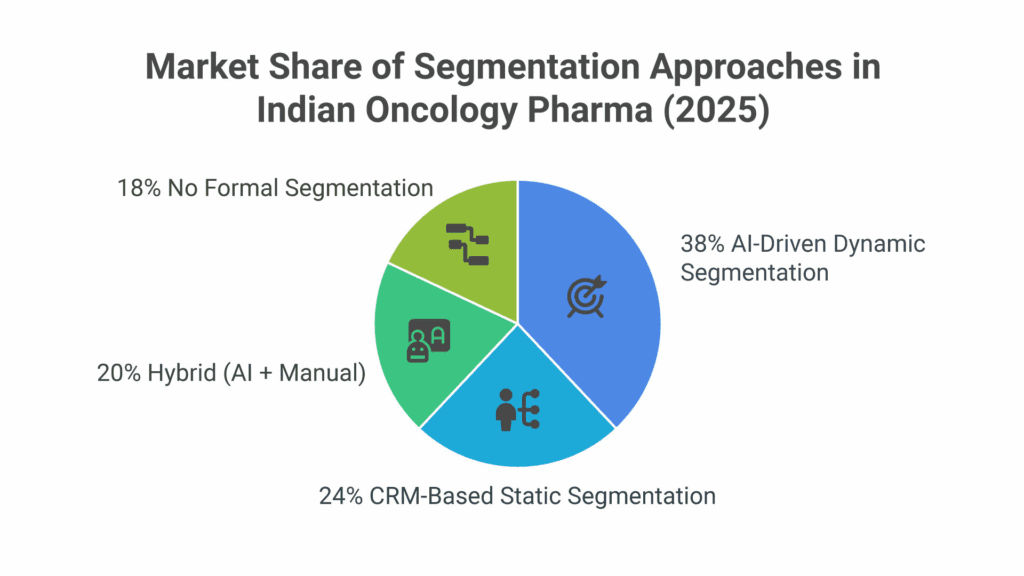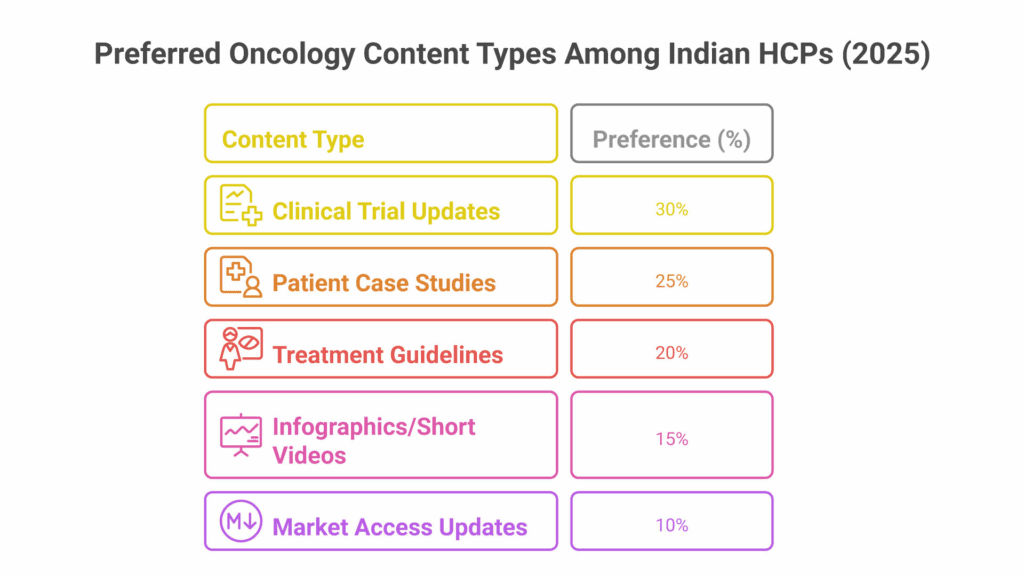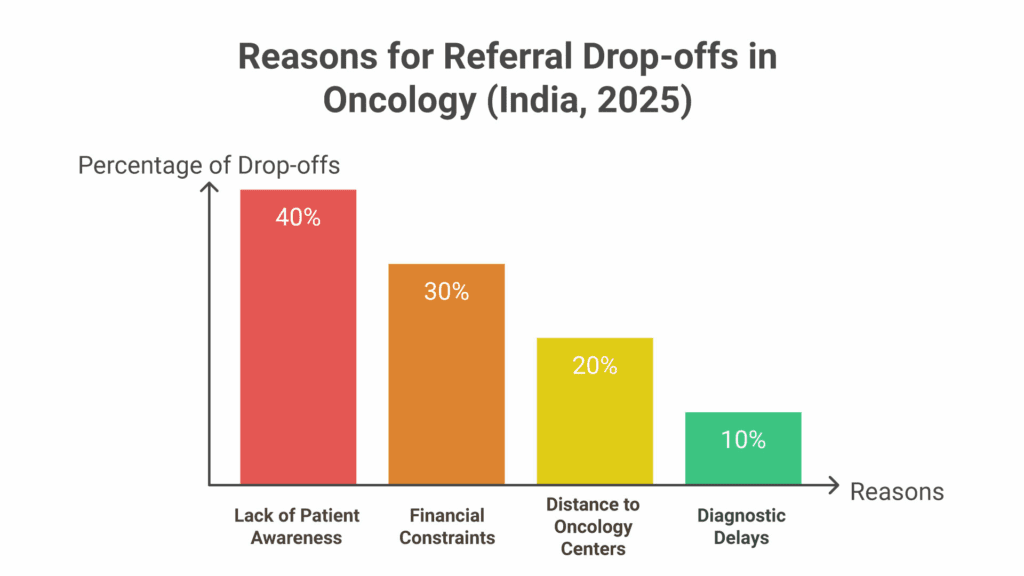Introduction: The Evolution of Pharma Marketing in Oncology
Over the past decade, the landscape of oncology has undergone a profound transformation, not just in treatments and diagnostics but also in how pharmaceutical companies approach their marketing strategies. Artificial Intelligence (AI) has emerged as a game-changer, reshaping traditional pharma marketing models and ushering in an era of precision-driven, hyper-personalized engagement.
In oncology, where treatment decisions are highly nuanced and patient journeys are complex, AI offers pharma marketers the ability to move beyond mass communication. It enables the delivery of timely, relevant, and contextually appropriate messaging tailored to the individual preferences and clinical priorities of healthcare professionals (HCPs).
With oncology being one of the most data-intensive therapeutic areas, encompassing genomics, biomarker profiling, electronic health records (EHRs), diagnostic imaging, and real-world evidence (RWE), AI provides unparalleled opportunities for insight generation and audience targeting.
A 2024 survey by Pharma Marketing Insights highlights this paradigm shift: 72% of oncology brand managers globally now view AI as not just a digital tool but a strategic imperative. In India, this trend is gaining rapid momentum. With over 1.4 million new cancer cases projected annually by 2026, the need for intelligent, data-driven, and ethically responsible oncology marketing has never been more critical.
AI is enabling pharma companies to optimize HCP segmentation, personalize content delivery, and drive measurable engagement across both digital and offline channels. This evolution is not just technological, it reflects a philosophical shift toward more patient-centric, outcomes-driven marketing models.
As the oncology ecosystem becomes increasingly complex, pharma marketers who embrace AI-powered strategies today will be better positioned to shape the future of cancer care communication.
Section 1: AI in HCP Segmentation and Targeting
Traditional segmentation models in pharma marketing relied on prescription data, geography, and sales rep inputs. Nevertheless, these models are frequently out-of-date, stagnant, and unable to adequately represent the intricate dynamics of cancer care.
AI has brought a dynamic shift.
Today’s oncology HCP segmentation leverages multi-source datasets:
- Prescription patterns
- Digital engagement behavior
- Conference attendance
- Social media activity
- Patient caseload and specialty focus
Example: AI-Driven HCP Profiling
Using machine learning models, pharma marketers can now classify oncologists into highly actionable segments:
- High-Volume Prescribers
- Clinical Trialists
- Digital Influencers
- Guideline Leaders
- Early Adopters
According to a 2025 survey by the Indian Oncology Marketers Association, when asked about their primary segmentation strategy:
- 38% of pharma companies used AI-driven dynamic segmentation
- 24% still relied on static CRM-based segmentation
- 20% used hybrid models (AI + Manual)
- 18% had no formal segmentation strategy

AI tools also help with territory alignment, call planning, and rep-triggered digital campaigns.
Key Tools Used:
- Salesforce Einstein
- Veeva Next Best Action AI
- IQVIA Orchestrated Customer Engagement
By integrating AI-driven HCP segmentation, pharma brands have seen up to 25% higher engagement rates in oncology marketing campaigns.
Section 2: AI-Powered Content Personalization
Content fatigue is a growing issue among oncologists. Over 65% of oncologists report being overwhelmed by pharma communications, as per a 2024 Oncologist Engagement Report.
AI can solve this through hyper-personalization.
How it Works:
- AI tracks how each oncologist interacts with different content formats (emails, webinars, social posts, research papers).
- Machine learning models predict content preferences, clinical data, patient case studies, or therapy guidelines.
- The system auto-curates and schedules personalized communication.
Personalization Variables Include:
- Preferred channel (email, WhatsApp, webinar)
- Preferred time of engagement
- Content type (scientific vs. patient-oriented)
- Call-to-action history
For example, an oncologist who frequently clicks on patient case studies and attends virtual tumor boards will receive more real-world evidence-focused content.

AI tools like Adobe Sensei, Salesforce Marketing Cloud AI, and Veeva Content AI are commonly used by pharma brand teams for real-time personalization.
Brands using AI-driven content personalization in oncology reported 2x higher open rates and a 1.7x increase in HCP engagement scores.
Section 3: Predictive Analytics for Campaign Optimization
In oncology pharma marketing, campaign optimization has evolved from being reactive to becoming predictive, thanks to Artificial Intelligence (AI). Instead of waiting for post-campaign metrics to assess performance, marketers can now use AI to forecast outcomes and adjust strategies in real time.
AI algorithms analyze vast historical data sets, including open rates, click-through rates, content dwell time, and engagement patterns across various channels. Additionally, AI integrates real-time feedback loops, providing continuous insights that allow for rapid campaign adjustments.
Key predictive metrics used by pharma marketers include:
- Propensity to Engage: Identifying which HCPs are most likely to interact with specific content types.
- Preferred Channel Future Behavior: Predicting whether an HCP will respond better to email, webinars, or social media outreach.
- Likelihood to Attend Webinars: Estimating webinar participation rates by analyzing past behaviors and topic preferences.
- Estimated Prescription Uplift: Projecting how particular ads might affect prescription intent and behavior.
For instance, an AI-driven analysis might reveal that oncologists in Tier 2 cities show a 70% likelihood of engaging with patient journey videos. Based on this, marketers can reallocate budgets toward that content format for better ROI.
A real-world case study highlights the impact: An Indian pharma company running a breast cancer therapy campaign leveraged AI tools for predictive targeting and achieved 35% higher click-through rates, 22% lower cost per HCP engagement, and an 18% rise in digital prescription intent.
Today, AI platforms like IQVIA OCE, Oracle Eloqua AI Suite, and Adobe Predictive Analytics are becoming standard solutions for oncology brand teams aiming for smarter, data-driven campaign optimization.
Section 4: AI in Referral Pathway Management
Referral management in oncology remains a critical gap in India’s healthcare ecosystem, especially across rural and Tier 2-3 towns.
AI-based referral management platforms can now:
- Track referral patterns from general practitioners (GPs) to oncologists
- Identify drop-off points in referral pathways
- Trigger auto-reminders and nudges to non-completing patients
- Generate heatmaps showing referral trends by region
A 2025 study by the Indian Medical Referral Network observed that:
- 45% of cancer referrals from primary care do not convert to oncology consultations within 30 days.
Pharma companies are now partnering with referral pathway tech platforms to sponsor diagnostic packages, organize referral awareness CMEs, and integrate AI-powered referral dashboards for GPs.

AI-driven referral management programs are showing a 25-30% improvement in referral-to-consultation conversion rates in pilot regions.
Section 5: Real-World Data (RWD) Driven Oncology Insights
In today’s oncology pharma marketing landscape, real-world data (RWD) has emerged as a strategic asset. RWD encompasses health-related data gathered from sources other than conventional clinical trials, including insurance claims, patient registries, electronic health records (EHRs), and diagnostic imaging reports. With the help of Artificial Intelligence (AI), pharma companies are now able to analyze and interpret these vast datasets to gain actionable insights that inform both marketing and patient care strategies.
AI-powered platforms can identify critical gaps in the patient journey, such as late diagnosis, poor treatment adherence, or regional disparities in care access. Pharma marketers are increasingly using AI-driven RWD analysis to map these pain points and design targeted interventions.
For example, by analyzing anonymized EHR data from over 50 oncology centers, a leading pharmaceutical brand uncovered a pattern of under-diagnosis of lung cancer in the eastern states of India. This insight prompted a series of focused marketing and educational initiatives, including region-specific awareness campaigns, Continuing Medical Education (CME) programs for pulmonologists, and sponsored low-cost screening drives in high-risk districts.
Beyond patient journey mapping, AI-driven RWD tools help pharma teams monitor off-label drug usage, track patient adherence trends, and measure treatment outcomes at a population level. This enables more precise HCP targeting and ensures that promotional efforts align with real-world clinical needs.
Global AI platforms like Flatiron Health, Tempus, and COTA are setting new benchmarks in oncology RWD analysis, and many Indian pharma teams are now adopting similar tools to refine their marketing strategies.
As oncology becomes increasingly personalized, the ability to leverage AI-analyzed real-world data will be crucial for pharma marketers striving to deliver more relevant, outcome-oriented campaigns.
Section 6: Ethical Considerations and Regulatory Compliance in AI-led Pharma Marketing
As Artificial Intelligence (AI) continues to revolutionize oncology pharma marketing, ethical challenges and regulatory compliance have become critical areas of focus. While AI-driven insights offer pharma companies immense advantages in HCP targeting, content personalization, and patient engagement, the responsible use of sensitive data remains a top priority.
The privacy of patient data is one of the most important ethical issues. With large volumes of electronic health records (EHRs), diagnostic data, and behavioral patterns being analyzed, compliance with global standards like the General Data Protection Regulation (GDPR) and India’s upcoming Personal Data Protection (PDP) Bill is essential. Pharma marketers must ensure that all patient data used for AI modeling is fully anonymized and protected against misuse.
Another sensitive area is HCP consent for behavioral tracking. AI models often rely on analyzing HCP digital footprints, from email engagement to webinar attendance, to tailor communication strategies. Regulatory bodies such as the Central Drugs Standard Control Organization (CDSCO) and the Indian Medical Association (IMA) now emphasize the need for clear and transparent consent mechanisms.
Furthermore, bias in AI algorithms poses a significant risk. If not regularly audited, AI systems may unintentionally favor certain physician segments or regions, leading to inequitable resource allocation.
To address these concerns, leading pharma companies are now implementing robust AI governance frameworks. These include:
- Regular algorithmic audits
- Bias detection and correction protocols
- Strong data anonymization measures
- Transparent communication with HCPs about the role of AI in targeting and content delivery
Ultimately, the future of AI-led oncology pharma marketing will depend on striking the right balance between technological efficiency and ethical responsibility, ensuring both regulatory compliance and stakeholder trust.
Conclusion: The Future of AI in Oncology Pharma Marketing
Artificial Intelligence (AI) in oncology pharma marketing has evolved from being an experimental technology to becoming a core driver of strategic decision-making and measurable business outcomes. Its impact is now visible across multiple facets of the pharma marketing value chain, from physician engagement to patient support.
AI’s role in dynamic HCP segmentation, hyper-personalized content delivery, predictive campaign optimization, and referral pathway management is helping pharma companies move away from generalized communication models to precision-focused, data-driven strategies. This shift not only enhances engagement rates but also ensures that marketing messages are clinically relevant and timely for each stakeholder across the oncology care continuum.
Looking ahead, the next wave of AI in oncology pharma marketing will witness even deeper technology integration. Key areas of evolution include:
- Omnichannel orchestration platforms that combine AI with CRM tools for seamless coordination across email, webinars, in-person visits, and social media.
- Voice and conversational AI tools that allow HCPs to receive instant, voice-activated medical updates or treatment guidance.
- Deployment of AI-powered virtual medical representatives who can interact with oncologists via chatbots or voice bots, reducing the dependency on physical sales rep visits.
- Expansion of AI-driven patient support programs that provide automated symptom management tips, appointment reminders, and medication adherence support.
However, alongside this rapid technological advancement, pharma companies must prioritize investments in internal AI literacy, ethical governance frameworks, and robust data governance models. Ensuring transparency in AI decision-making, safeguarding HCP and patient privacy, and continuously auditing AI algorithms for bias will remain non-negotiable requirements.
The oncology treatment landscape itself is evolving at a fast pace with innovations like personalized medicine, immuno-oncology, and targeted therapies. AI will play a pivotal role in helping pharma marketers keep pace with this clinical transformation.
In this new era, success will no longer be defined by how frequently a brand communicates with its audience but by how relevant, timely, and responsible each interaction is. As the new mantra in pharma marketing goes:
“It’s no longer about reach and frequency. It’s about relevance, timeliness, and responsibility, powered by AI.”
Pharma companies that embrace this AI-driven mindset today will be best positioned to lead tomorrow’s oncology care conversations.
The Oncodoc team is a group of passionate healthcare and marketing professionals dedicated to delivering accurate, engaging, and impactful content. With expertise across medical research, digital strategy, and clinical communication, the team focuses on empowering healthcare professionals and patients alike. Through evidence-based insights and innovative storytelling, Hidoc aims to bridge the gap between medicine and digital engagement, promoting wellness and informed decision-making.



